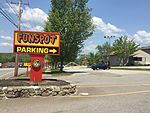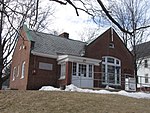WWLK-FM
1989 establishments in New HampshireBelknap County, New HampshireRadio stations established in 1989Radio stations in New HampshireSoft adult contemporary radio stations in the United States ... and 1 more
Use mdy dates from July 2023
WWLK-FM (101.5 MHz) is a commercial radio station licensed to Meredith, New Hampshire, and serving the Lakes Region. The station broadcasts a soft adult contemporary radio format and is owned by Dirk Nadon, through licensee Lakes Media, LLC. The studios and offices are on Church Street in Concord, New Hampshire.WWLK-FM has an effective radiated power (ERP) of 6,000 watts. The transmitter is on Pickerel Pond Road at Parade Road in Laconia, New Hampshire.
Excerpt from the Wikipedia article WWLK-FM (License: CC BY-SA 3.0, Authors).WWLK-FM
Pickerel Pond Road, Laconia
Geographical coordinates (GPS) Address Nearby Places Show on map
Geographical coordinates (GPS)
| Latitude | Longitude |
|---|---|
| N 43.596 ° | E -71.498 ° |
Address
WLNH-FM (Laconia)
Pickerel Pond Road
03246 Laconia
New Hampshire, United States
Open on Google Maps








